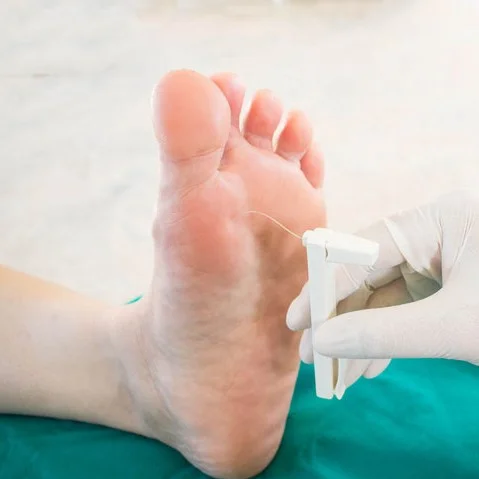Diabetes Foot Assessment
Did you know that most foot and leg problems can be prevented?
Diabetes in Australia
According to Diabetes Australia, 280 Australians develop diabetes every day. It’s a very serious and complex medical condition, which can affect the whole body — and the feet are not exempt!
Unfortunately, people with type 2 diabetes commonly experience no—or very subtle—symptoms initially, which leads to delayed diagnosis. As a result, diabetes complications may have already developed before treatment starts. This is a big part of the reason why the total annual cost impact of diabetes in Australia is estimated to be a whopping $14.6 billion. More importantly, diabetes can have a significant impact on quality of life and can reduce life expectancy.
How does diabetes affect your feet?
Diabetes can affect the feet in many ways but there are 2 major concerns:
- Reduced blood flow due to narrowing and hardening of the blood vessels in the lower legs and feet, which is called peripheral arterial disease. This leads to pain, reduced healing capacity and resistance to infection.
- Reduced or complete loss of sensation, which is called peripheral neuropathy. This develops due to damage to the nerves in the feet and is often painless. However, it’s still a huge problem because if you can’t feel your feet getting damaged you obviously won’t do anything about it. Think about the damage a rock in your shoe could do to the skin on the bottom of your foot if it’s been there for a couple of weeks!
When combined with neglect, reduced blood flow and loss of sensation commonly result in the development of a foot ulcer. This is really serious stuff, as—if not managed properly from the get-go—a foot ulcer can result in amputation. Think that won’t happen to you? According to Diabetes Australia, there are more than 4,400 amputations every year in Australia as a result of diabetes.
It seems all doom and gloom, but the good news is that diabetes foot complications are avoidable. We hope that this information will inspire you to take the management of diabetes, including your feet, more seriously so that you never experience any diabetes complications. Feel free to get in touch with Fairfield Podiatry to talk through your concerns.
How to avoid diabetes complications
- See your podiatrist every 12 months for a diabetes foot assessment and more regularly for toenail and skin care if you have difficulty attending to your feet.
- Thoroughly check your feet every day for undetected trauma to your toenails and skin.
- When washing and drying yourself, don’t forget about your feet, particularly between your toes. This will significantly reduce your risk of developing a fungal infection.
- Apply moisturising cream to your feet every day. It’s particularly important to do this if certain areas, such as the heels, are prone to getting very dry and cracked. You’ll feel much more comfortable and stop bacteria from creeping into the cracks to cause a nasty infection.
- Check the inside of your shoes before putting them on for potential causes of trauma (e.g. rock, exposed plastic).
What will happen during your diabetes foot assessment?
Your feet will be examined for accidents waiting to happen. Examples include an ingrown big toenail, a corn on your little toe or a bunion that’s gradually increasing in size and starting to show signs of shoe irritation. Your podiatrist will also make sure your socks and shoes fit properly.
After completing a diabetes foot assessment, your podiatrist will let you know your diabetes foot complications risk status. Hopefully, this is very low. If there are any concerns, your podiatrist will implement an individualised plan of attack to give you the best possible chance of keeping your feet in tip-top shape.
Last but not least, your podiatrist will send a letter to your doctor that summarises your diabetes foot assessment results and management plan moving forward.


